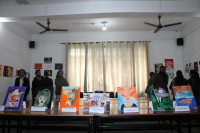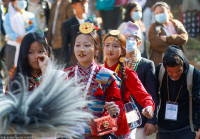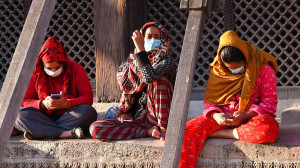Culture & Lifestyle
A complex, ambitious portrait of the Himalayas
In ‘Himalaya: A Human History’, Ed Douglas blends geology, religion and politics to show how the mountains shaped (and were shaped by) people.
Michael Siddhi
When Han Suyin, the Chinese-born Eurasian writer, arrived in Nepal in 1956 to attend King Mahendra’s coronation, she was inspired to write the book ‘The Mountain is Young’, which captured the fragments of Kathmandu’s coming-out party and the boozy world of Boris Lissanevitch, who opened Nepal to the world.
Three years earlier, in 1953, Edmund Hillary and Tenzing Norgay had conquered Everest, placing Nepal firmly on the global map—a time when Nepal was emerging from a tumultuous past and centuries of isolation to engage with the modern world. Those years marked the dawn of the modern mountaineering era and growing fascination with the Himalayas.
Meanwhile, to the north, another seismic shift was underway: Mao’s Communist Party established the People’s Republic of China and occupied Tibet in 1950. Few know that this was not the first invasion of Tibet. In 1903–04, Francis Younghusband led a British expedition that decimated Tibet’s ill-equipped army, forcing the 13th Dalai Lama to flee to Mongolia’s capital, Urga.
In his book ‘Himalaya: A Human History’, Ed Douglas captures the sweeping narrative of the human history of the Himalayan region—tracking the region’s geo-political upheavals, shifting political landscape, changing hands of political powers, and the interplay of diplomacy, all packed into a 600-page, powerful book.
The book begins with the origin of the Himalayas. Drawing from various scientific research and evidence, Douglas reminds us that Everest once lay beneath the sea. The Himalaya, he writes, “are being made and unmade constantly,” a phrase that captures both the region’s restless geology and its ever-changing cultures. From the mountains, Douglas moves on to the history of mountain people, arguing that the region’s geography has shaped their history, culture, and idealism.
His account of how local religions merged with imported ideas is particularly illuminating. Before Buddhism, Tibet’s landscape was dominated by deities such as the warrior god Pehar and the Bon religion. When Vajrayana Buddhism arrived, it didn’t erase the old faith but fused with it, creating an esoteric tradition unique to Tibet. As Douglas notes, cultures don’t simply accumulate like geological layers—they metamorphose under pressure to conform to the demands of the evolving world around them.
The analysis of Nepal’s transformation is equally compelling. Having long read history, I believed I understood the rise of the Gorkha dynasty. But Douglas’s account reframes it in colours which I had not earlier considered. He traces the dynasty’s hazy origins to the men from the plains, sprinkled with Rajput spice, who regarded themselves as nature’s rulers and looked down on the shamanism-practising Khas parbatiya.
Douglas argues that the local Khas people, later fused with Rajput migrants brought hierarchical Hinduism. The Khas elites absorbed these Brahminical ideas, reinventing themselves as Kshatriyas—Chhetris of today. It’s a fresh sociocultural lens to view Nepal’s cultural stratification. Douglas’ portrayal of Prithivi Narayan Shah combines admiration and critique: a visionary strategist, ruthless when needed and an astute diplomat who understood statecraft.
In stories, such as Prithivi’s men going incognito as farmers to attack Nuwakot or cutting the noses of men in Kirtipur, or the advice from his memoir Divya Upadesh, readers may find echoes of Machiavelli. Even familiar events are retold with surprising twists. In our history lessons, we were taught that Captain Kinlock of the British East India Company was defeated by the Gurkhas. Douglas clarifies that Kinloch never reached Kathmandu at all. His troops perished in the malaria-ridden Tarai forest. Such details remind us how history, retold, can reshape national myths.
The book serves as a lesson in statecraft and political diplomacy. The author dissects the delicate power plays between Nepal, Tibet, and other Himalayan nations. He examines how diplomacy would be Panchen Lama’s undoing, or Junga Bahadur Rana, whom Douglas calls a tyrant mastered diplomacy and ensured his dynasty’s survival. The book often feels like a record of cold, strategic power politics unfolding in the high Himalayas.
‘Himalaya: A Human History’ also weaves in vivid portraits of European travellers and explorers who ventured into the Himalayan countries. Douglas suggests that Hergé, the Belgian comic artist, may have drawn inspiration from his friend Han Suyin’s travels for the comic strip—‘The Tintin in Tibet’. The account of Sir Francis Younghusband, architect of the first Everest expedition in 1921 is particularly engaging.
Capturing the absurdity and romance of mountaineering, George Mallory had written on July 12, 1921 from the Second Advanced Camp, “I sometimes think of this expedition as a fraud from beginning to end, invented by the wild enthusiasm of one man Younghusband”. The author celebrates the scientific curiosity of the colonial age, like Captain Charles, part of the British trade mission to Kathmandu, who created the first map of the valley and was amongst the first to suggest that Nepal’s mountains were the world’s tallest.
The book brims with such stories of cartographers, philologists, surveyors, mathematicians, scientists, and geographers who sought to measure and decode the Himalayas.
While the book’s richness makes it a fascinating read, it is also heavy and exhausting at the same time. The narratives are mostly non-linear, storylines that zig zag across different timelines, jumping from Kathmandu’s gods to Mongol empire, from Buddhist gurus to British diplomacy—can leave readers restless. It is a book that has to be painstakingly savoured, one layer at a time.
Douglas’s claim that he could see Everest from Ratna park, seems implausible, given that by 1995 Kathmandu’s skyline had already veiled the peaks. If this observation stretches credibility, one wonders how much of his accounts of Tibet or China might have been oversold. The rich accounts of mountaineers, their triumphs, failures, and philosophical musings are fascinating but overwhelming. Despite the depth of his work, his coverage of the Sherpas who made those ascents possible feels cursory.
He mentions Albert Frederick Mummery’s fatal Nanga Parbat expedition with two “Gurkha” aides, Raghubir and Goman Singh, names that hardly sound Gurkha. Such lapses briefly dent the credibility of an otherwise remarkable work. While we may not agree with all of Ed Douglas’s interpretations and his heavy-handed writing, one cannot help but admire the scope of his research and his meticulous storytelling.
As a Nepali reader, I found the book enlightening and provocative. It made me reflect on how external powers have long shaped the region’s destiny. From Bhimsen Thapa’s rise and fall to Junga Bahadur’s diplomacy, from Mathbar Singh’s murder to Matrika Koirala’s premiership, Nepal’s political fate has often depended on the goodwill of our neighbor—whether it be the British Raj or later the independent India.
Other smaller Himalayan kingdoms and nations like Tibet, Sikkim, Ladakh, and Bhutan were exposed to comparable regional diplomacy and geopolitical manoeuvring. That influence persists even today; the levers may have changed, but not the hands that pull them. Douglas’s Himalayan history, viewed from this lens, feels eerily contemporary.
The delicate political landscape and fragile borders that once allowed China to annex Tibet and enabled India to incorporate Sikkim after a referendum could easily set the stage for similar shifts today. If history is cyclical, further territorial reconfiguration in the Himalayas cannot be ruled out—and if it occurs, it will reflect our failure to learn from the past.




 10.12°C Kathmandu
10.12°C Kathmandu













%20(1).jpg&w=300&height=200)

